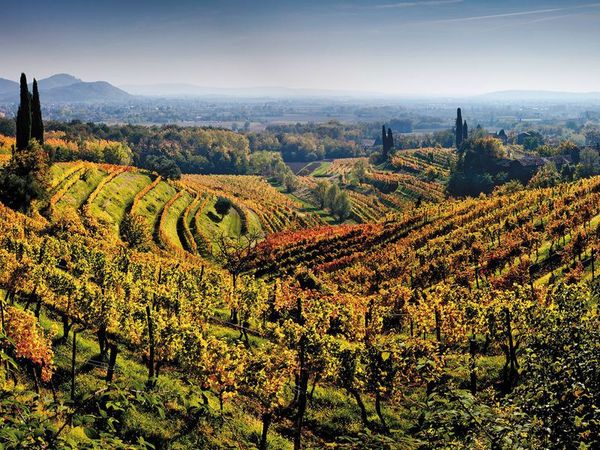
Italian wines are famous for their incredible range of indigenous grapes, regions and styles. Such diversity can encourage conservative drinking, however: playing safe, and sticking to the tried and tested grapes and familiar regions. But throw vinous caution to the wind, and you will soon discover under-the-radar regions producing terrific wines from both indigenous and international grapes.
One such region is Friuli-Venezia Giulia (Friuli, for short) – a wine region located in the North-Eastern part of Italy with a very long history of wine production. For the history-minded, it’s worth noting that this region was part of the Austro-Hungarian empire, and as such, only became Italian in the early 20th Century! The influence of its neighbours, Slovenia and Austria, has added a fascinating dimension to Friuli’s winemaking traditions. Friuli extends from the Alps to the Adriatic coast, and specialises in aromatic, floral and crispy whites known for their bright acidity. The white wines of the region are often vinified as varietals – though there are blends too. These include international grapes such as Pinot Grigio, Chardonnay and Sauvignon Blanc, but also indigenous grapes such as Friulano, Ribolla Gialla, Verduzzo and the relatively rare Picolit. While there are also some excellent reds produced in the region, including some made from uniquely flavoured grapes such as Refosco and Schioppettino – I will concentrate on the still whites here. What makes the whites of Friuli rather special is their ability to marry beguiling lightness with substance of fruit and texture. The important four DOCs in the region are worth sketching out; they are Collio, Friuli Colli Orientalli, Friuli Isonzo and Friuli Grave.
The Collio (meaning “hills”) region has a long history of wine production and is closely connected to its Slovenian neighbour. Indeed, some Collio wine producers’ own vineyards on both side of the border. The region is influenced by the cool Bora wind and white wines here are full of verve; they are notable for their pure fruit flavours, and many have the structure to age, due in part to their bright acidity. Only a small percentage of Friuli’s wines are produced here, but the wines tend to receive high accolades – in part due to reliance on small, independent producers championing low yields. More recently, experimental producers such as Josko Gravner and (the late) Stanko Radikon have pioneered skin-contact and amphora-matured whites in the region, producing orange (also known as amber) winesfor laying down. These command great praise – with prices to match!
Friuli Colli Orientali (meaning “Eastern Hills” of Friuli) has some of the most prestigious vineyards in the region, which are planted at a slightly higher elevation to those in the Collio. Viticulture has existed here since Roman times and most production is of whites, though there are reds too. The grape most associated with the region is the indigenous Friulano, which makes for aromatic and crisp wines with notes of peach, citrus, fennel/dill and sometimes mellow honey notes. Another interesting grape to note is Ribolla Gialla, the best examples of which can produce wines of fresh citrus and orchard fruit notes, savoury herbaceous undertone and a waxy texture.
Friuli Isonzo is in the south-eastern part of the Friuli and is relatively small. Unlike the Collio and Colli Orientali regions, this area lies on an alluvial plain running along the Isonzo river from which it takes its name. The area is influenced by warm winds from the Adriatic as well as cooler winds from mountains to the north. The diurnal variation in temperature makes for quality white wines, with lively acidity and freshness. Although some red wines are produced here, it’s grapes such as Sauvignon Blanc, Pinot Bianco, Pinot Grigio and Chardonnay that had put the region on the map.
Friuli Grave is the largest DOC in Friuli and covers an area that spreads between the Julian Alps and the Adriatic. The alluvial, gravelly soil (alluded to in the region’s name) is limestone rich, which makes it perfect for white wine production. One can find the local Friulano grape here, but also international star grapes such as Sauvignon Blanc, Pinot Grigio and Chardonnay. These whites are aromatic, crisp and appetising and work wonderfully with fish, risotto, light pasta dishes, as well as making for a perfect aperitif.
The white wines of Friuli would make an excellent choice of drink for any wine lover who appreciates fresh and well-defined fruit, aromatic expression and lively acidity in their wine. These wines communicate their location and climate, offering interest and food-friendliness. Friuli Pinot Grigio alone offers a more expressive, fruity and zesty experience, a stark contrast to the anodyne, bulk-produced Pinot Grigio on every supermarket shelf. And for fans of unique local grapes, the aromatic and rounded texture of Friulano, or the tingling citrus verve of Ribolla Gialla is easy to fall in love with. These whites are not just for summer sipping – they will delight and surprise you with their sheer energy and charm allyear round. If you are a white wine lover, this region should be firmly on your radar.
Inbar Galinsky-Johnson, FWS
Some Friuli wines to try:
Ribolla Gialla: thewinesociety.com, marksandspencer.com, quaffwine.com
Friulano: southdownscellars.co.uk, tanners-wines.co.uk, laywheeler.com
Pinot Grigio: tannico.co.uk, vivino.com, bernabei.co.uk
Chardonnay: tannico.co.uk, southdownscellars.co.uk
Orange/Skin-contact Wine: butlers-winecellar.co.uk

